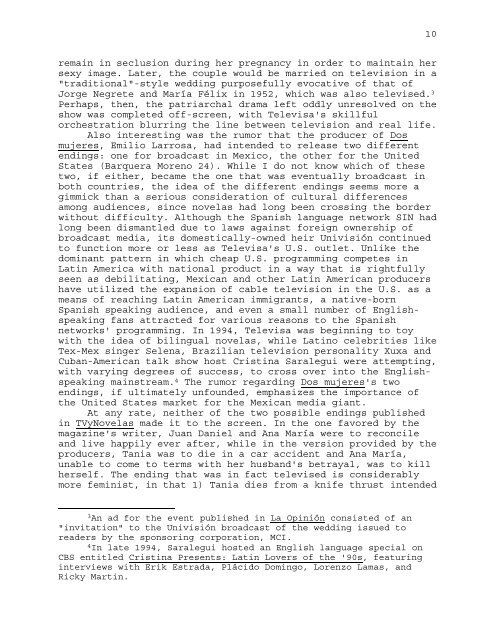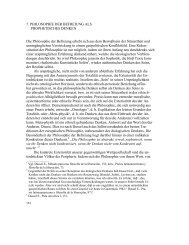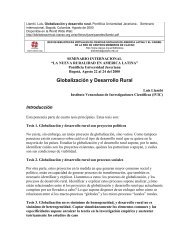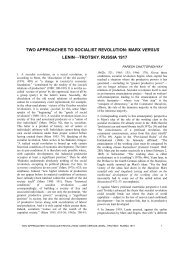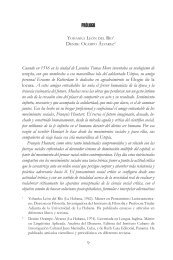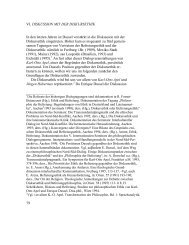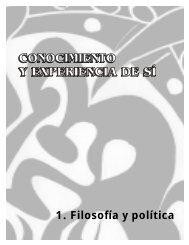1 LOS MACHOS TAMBIEN LLORAN: TELEVISA AND ... - CLACSO
1 LOS MACHOS TAMBIEN LLORAN: TELEVISA AND ... - CLACSO
1 LOS MACHOS TAMBIEN LLORAN: TELEVISA AND ... - CLACSO
Create successful ePaper yourself
Turn your PDF publications into a flip-book with our unique Google optimized e-Paper software.
emain in seclusion during her pregnancy in order to maintain her<br />
sexy image. Later, the couple would be married on television in a<br />
"traditional"-style wedding purposefully evocative of that of<br />
Jorge Negrete and María Félix in 1952, which was also televised. 3<br />
Perhaps, then, the patriarchal drama left oddly unresolved on the<br />
show was completed off-screen, with Televisa's skillful<br />
orchestration blurring the line between television and real life.<br />
Also interesting was the rumor that the producer of Dos<br />
mujeres, Emilio Larrosa, had intended to release two different<br />
endings: one for broadcast in Mexico, the other for the United<br />
States (Barquera Moreno 24). While I do not know which of these<br />
two, if either, became the one that was eventually broadcast in<br />
both countries, the idea of the different endings seems more a<br />
gimmick than a serious consideration of cultural differences<br />
among audiences, since novelas had long been crossing the border<br />
without difficulty. Although the Spanish language network SIN had<br />
long been dismantled due to laws against foreign ownership of<br />
broadcast media, its domestically-owned heir Univisión continued<br />
to function more or less as Televisa's U.S. outlet. Unlike the<br />
dominant pattern in which cheap U.S. programming competes in<br />
Latin America with national product in a way that is rightfully<br />
seen as debilitating, Mexican and other Latin American producers<br />
have utilized the expansion of cable television in the U.S. as a<br />
means of reaching Latin American immigrants, a native-born<br />
Spanish speaking audience, and even a small number of Englishspeaking<br />
fans attracted for various reasons to the Spanish<br />
networks' programming. In 1994, Televisa was beginning to toy<br />
with the idea of bilingual novelas, while Latino celebrities like<br />
Tex-Mex singer Selena, Brazilian television personality Xuxa and<br />
Cuban-American talk show host Cristina Saralegui were attempting,<br />
with varying degrees of success, to cross over into the Englishspeaking<br />
mainstream. 4 The rumor regarding Dos mujeres's two<br />
endings, if ultimately unfounded, emphasizes the importance of<br />
the United States market for the Mexican media giant.<br />
At any rate, neither of the two possible endings published<br />
in TVyNovelas made it to the screen. In the one favored by the<br />
magazine's writer, Juan Daniel and Ana María were to reconcile<br />
and live happily ever after, while in the version provided by the<br />
producers, Tania was to die in a car accident and Ana María,<br />
unable to come to terms with her husband's betrayal, was to kill<br />
herself. The ending that was in fact televised is considerably<br />
more feminist, in that 1) Tania dies from a knife thrust intended<br />
3 An ad for the event published in La Opinión consisted of an<br />
"invitation" to the Univisión broadcast of the wedding issued to<br />
readers by the sponsoring corporation, MCI.<br />
4 In late 1994, Saralegui hosted an English language special on<br />
CBS entitled Cristina Presents: Latin Lovers of the '90s, featuring<br />
interviews with Erik Estrada, Plácido Domingo, Lorenzo Lamas, and<br />
Ricky Martin.<br />
10


